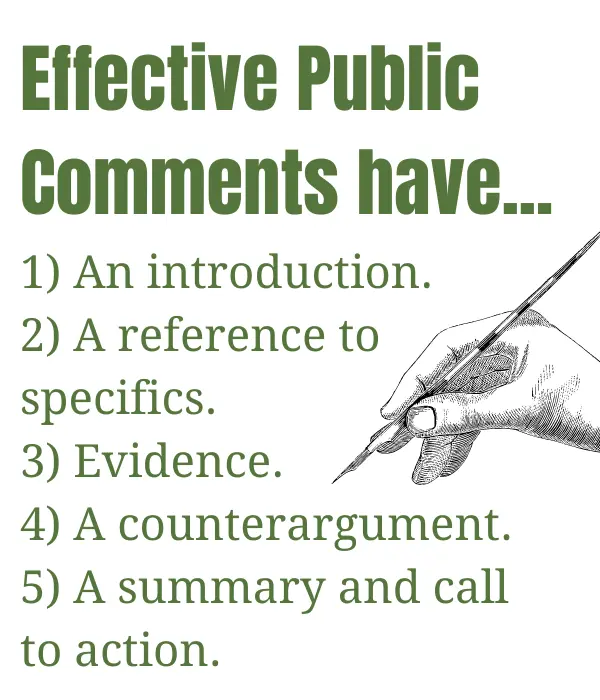The public comment is one aspect of free speech in America. There are many other avenues for this type of free speech, like writing to elected representatives, lobbying, organizing a community, or voting. But a public comment is different from any of these. It is a chance to give your argument about a policy proposal that affects you in your daily life. Fortunately the federal government is transparent about public comments and how to write an effective one.
Public comments can be involved in any number of proposals to enact changes in policy, from the school level all the way up to the federal level.
The Byway’s area is loosely populated. Most people would not think its residents would have to coordinate with the federal government on many local affairs; but they would be wrong. Within the three counties, there are three national parks and one large national monument which is home to 1,870,000 acres of public lands.
Everyone — in this area and outside of it — has different ideas about how, or whether, the federal government should be doing its job in this area. That is fine; they have a right to. What is important is that locals and federal agencies know how to communicate when the time comes for cooperation.
The Requirement for Public Comment
According to NEPA, federal agencies are required to open most significant rule change proposals to public comment.
“In general, agencies will specify a comment period ranging from 30 to 60 days in the ‘dates’ section of the Federal Register document, but the time period can vary,” says A Guide to the Rulemaking Process, a resource created by the Office of the Federal Register. “For complex rulemakings, agencies may provide for longer periods, such as 180 days or more. Agencies may also use shorter comment periods when that can be justified.”
Recently the Grand Staircase and other recreational areas along the Byway have gone through multiple public comment periods.
There are five elements of an effective public comment: 1) an introduction, 2) a reference to the specific part of the document you would like to address, 3) evidence, 4) a counterargument, 5) a summary and call to action.

Introduction
An introduction is a short opportunity to greet the person reading comments. It’s also a great chance to introduce them to who you are and how you will be affected by a rule change in a proposal.
The introductions that are strongest usually do not take a lot of space. They are just long enough to identify your experience and tie the issue to a human.
Reference to Specifics
The next part of the comment is also quite short. It includes a reference to the specific proposal and passage with which the commenter has a grievance.
The people reading public comments are government employees. It is their job to sort through hundreds of comments every day. Knowing exactly what they are looking at will give them a better chance of understanding your argument.
The Office of the Federal Register also specified that public comments have a specific purpose. Agencies will give particular alternatives or ask questions to the public. Answer those questions, and it is a whole lot more likely your concerns will not fall on deaf ears.
Evidence
Evidence is probably the most important part of an effective public comment. Prove to the agency that you have considered all of the potential consequences of the proposal — as the public expects agencies to have done — and come to a conclusion about why it is or is not right. Base your conclusion on statistics, scientific studies, or revenue metrics.
One common misconception is that a public comment is a declaration of support or opposition. A public comment is not a vote. It is more than that. It is a chance for you to make a well-informed argument for your side.
Counterargument
Before you close, make sure to address the counterargument. This is another chance for you to prove to the agency that you have done your research. Explain the other point of view, and then explain why yours might be better in this case.
Summary and Call to Action
Finally, end with a summary of your position, thank the agency, and call them to action.
“At the end of the process, the agency must base its reasoning and conclusions on the rulemaking record,” wrote the Office of the Federal Register, “consisting of the comments, scientific data, expert opinions, and facts accumulated during the pre-rule and proposed rule stages.”
An effective public comment will take such reasoning, data and facts into account. And if the system is working properly, the comment will be heard.
– by Abbie Call
Feature image courtesy of Abbie Call, The Byway.

Abbie Call – Cannonville/Kirksville, Missouri
Abbie Call is a journalist and editor at The Byway. She graduated in 2022 with a bachelor’s degree in editing and publishing from Brigham Young University. Her favorite topics to write about include anything local, Utah’s megadrought, and mental health and meaning in life. In her free time, she enjoys reading, hanging out with family, quilting and hiking with the dog she’s getting soon — fingers crossed.
Find Abbie on Threads @abbieb.call.

